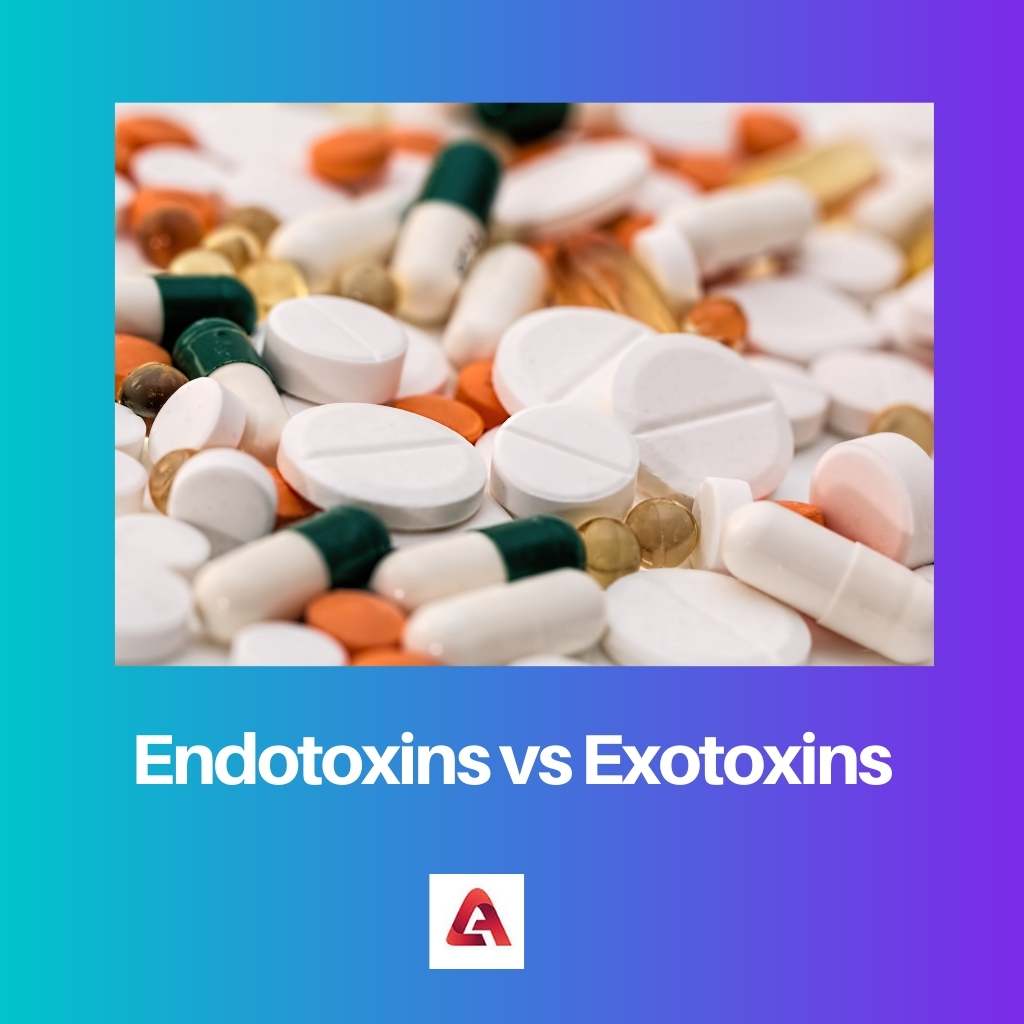Toxins are produced by pathogenic bacteria. Endotoxins are considered heat liable proteins that are specifically produced or secreted by certain species of gram bacteria.
Exotoxins are lipopolysaccharide complex type of protein that is liberated after the death of bacteria. Both of these toxins vary from each other in chemical nature and other aspects as well.
Endotoxins are consisted of lipids and secreted by some specific species of bacteria. Exotoxins, on the other side, consist of proteins.
Key Takeaways
- Endotoxins are toxins released when certain types of bacteria die, while exotoxins are toxins secreted by living bacteria.
- Endotoxins are less potent than exotoxins but can cause many symptoms and illnesses.
- Exotoxins are highly specific in their effects, targeting specific organs or cell types in the body.
Endotoxins vs Exotoxins
The difference between endotoxins and exotoxins is that endotoxins are a type of toxin released by gram bacteria, and it is present in the out sheath area of the cell wall. It is also called lipopolysaccharides. On the contrary, exotoxins are released with organism development. This type of toxin is contagious and may cause damage to various parts of the body. They are more toxic as compared to endotoxins. Even a single molecule can affect a large number of host cells.

Endotoxins are secreted or released from the outer area of the cell wall of bacteria after its death. These toxins are comprised of lipoglycan complexes and are also called lipopolysaccharides.
Endotoxins are moderately toxic and are not very active. Hence a large volume or amount of toxin is required to cause disease.
Exotoxins are toxins produced or developed inside pathogenic bacteria as an integral part of their metabolism and growth. These are majorly produced by gram-negative bacteria and gram-positive bacteria.
Exotoxins are highly toxic as a single molecule of toxin can act or affect a large number of host cells and cause harm to various parts or organs of the body.
Comparison Table
| Parameters of Comparison | Endotoxins | Exotoxins |
|---|---|---|
| What is it? | Endotoxins are released by an integral part of the bacteria’s cell wall and are mostly produced by gram-negative bacteria. | Exotoxins are developed or produced inside pathogenic bacteria as an integral part of their metabolism and growth. |
| Toxicity | These toxins are moderately toxic | These toxins are highly toxic |
| Neutralization | Antibodies cannot neutralize endotoxins | Antibodies can neutralize exotoxins |
| Detection | These types of toxins can be detected by Limulus lysate assay | Many tests, like precipitation, neutralization, etc., can detect or locate these toxins. |
| Disease Caused | Disease caused by endotoxins is sepsis by gram-negative rods, meningococcemia, etc. | Diseases caused by exotoxins are diphtheria, botulism, tetanus, etc. |
What is Endotoxins?
Endotoxins are released by an integral part of the bacteria’s cell wall and are mostly produced by gram-negative bacteria. These toxins are also called lipopolysaccharides.
Endotoxins are mostly composed of three components including, O negative antigen, Lipid A, and core oligosaccharide.
Endotoxins are moderately toxic and not very active on their substrate. Its molecular weight is nearly 50-1000KDa. Catalase, lgG/IgA proteases, and catalyse are the enzymes present in these toxins.
These toxins are secreted after the death of the bacteria. Endotoxins have low potency; hence, a large amount of toxin is required to affect a part or cause disease.
What are Exotoxins?
Exotoxins are developed or produced inside pathogenic bacteria as an integral part of their metabolism and growth. Gram-negative bacteria and gram-positive bacteria produce these toxins.
The molecular weight of these toxins is 10KDa. Exotoxins are composed of basically two subunits, A and B. Subunit A is nearly to have catalytic activity, while on the other side, subunit B is required for binding with the correct or appropriate cell receptors.
Nuclease, hyaluronidase, certain protease, collagenase, phospholipase A, and neuraminidase are the enzymes present in exotoxins. These toxins are highly toxic.
A single molecule can affect or act on a large number of host cells. These can be neutralized effectively by antibodies.
Main Differences Between Endotoxins and Exotoxins
- Toxins are produced by pathogens, which are the root cause of several infections. Endotoxins and exotoxins both are toxins that are produced by different bacteria. Endotoxins are released by an integral part of the bacteria’s cell wall and are mostly produced by gram-negative bacteria. On the contrary, Exotoxins are developed or produced inside pathogenic bacteria as an integral part of their metabolism and growth.
- Endotoxins are composed of lipoglycan complexes, and gram-negative bacteria produce these. On the other side, exotoxins are composed of polypeptides, and these toxins are majorly produced by two types of bacteria: gram-negative and gram-positive.
- Toxins are toxic, and their major role is to affect or cause harm to various parts of the organs. Endotoxins are moderately toxic, which means a large volume of toxins is required to cause disease. On the contrary, exotoxins are highly toxic, and a single molecule can affect a large number of host cells.
- Endotoxins and exotoxins are comprised of some specific components. Endotoxins are comprised or composed of three components including, O negative antigen, Lipid A, and core oligosaccharide. On the contrary, exotoxins are comprised of basically two subunits, A and B. Subunit A is near to have catalytic activity, while on the other side, subunit B is required for binding with the correct or appropriate cell receptor.
- Various diseases are caused due to these toxins that are produced by specific bacteria. Endotoxins cause diseases like sepsis by gram-negative rods, meningococcemia, etc. On the other side, diphtheria, botulism, tetanus, etc., are diseases caused by exotoxins.



